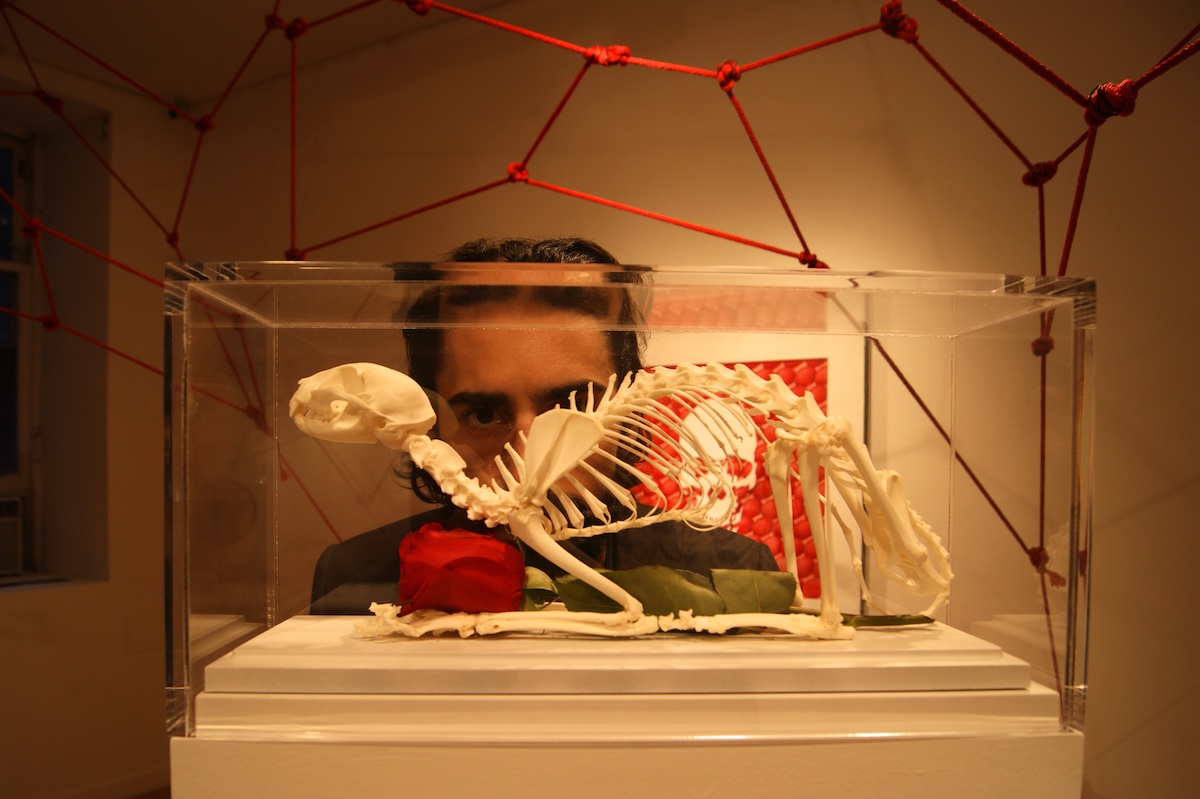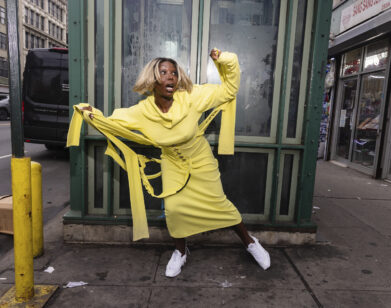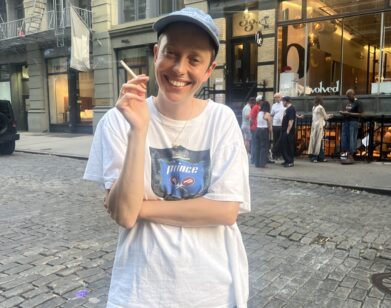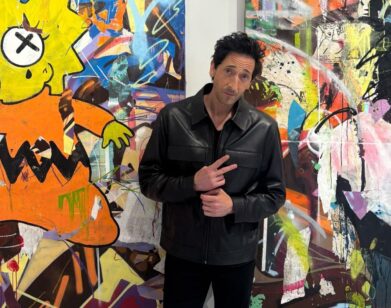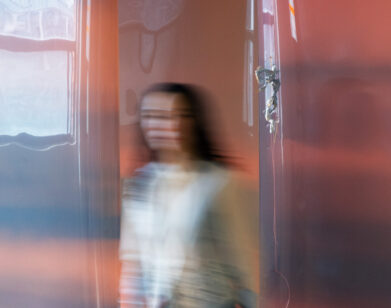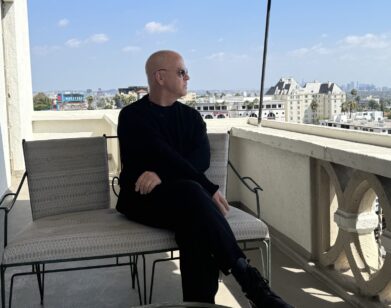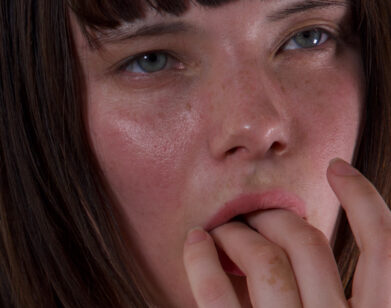Spiderwebs and Skyscrapers: Joseph Grazi’s ‘Happy Place’
PHOTOS OF JOSEPH GRAZI, ABOVE, BY MIA TYLER; IMAGE OF BAT HEART COURTESY OF JOSEPH GRAZI/ARTNOW NY
Though Lou Reed tragically passed just recently, the art-punk spirit that Reed made synonymous with New York City is as alive as ever—at least judging by the latest solo exhibition of emerging artist Joseph Grazi, “Happy Place” at ArtNow NY gallery. A native New Yorker with a penchant for tight-fitting black clothing, wild hair, and raucous opening parties that feature some of the lights of the city’s rock scene, Grazi is an artist with a music habit. He grew up with a guitar in his hand and now plays in a band called Ferrari Truck, bringing a boundary-less sensibility to the city’s underground venues.
Grazi’s new show of drawings and sculptures explores rock’s gothic side—despite its name, he says, it’s all about death. But this is a look at the paradoxical beauty of death and its dualism. A heart-shaped silhouette covered in 122 taxidermied bats provides the show’s surreal centerpiece.
When we spoke to Grazi just before his opening, he had only slept an hour the previous night, which he spent installing the show and “yelling at my artworks like they were my children.” We talked about his musical inspirations, his childhood doodling habits, and why we need to unleash our inner cavemen.
KYLE CHAYKA: Your new exhibition “Happy Place” is a dramatic explosion, with pieces all over the walls and floor. There are cat skeletons, bats, and guns. What is the narrative you’re trying to create?
JOSEPH GRAZI: The show is about the beauty of the parallels between life and death and the irrationality of human aesthetics. There’s no difference between a skull and a rose, they’re really the same thing, what nature decided they would look like. But one is horrifying to a person and one isn’t. I’m trying to illustrate that dichotomy.
I’m also exploring the tradition of glorifying the dead in an aesthetic way, the way the Egyptian pharaohs would mummify bodies. I’m taking monkeys and cats and giving them these Plexiglas coffins to rest on. The aesthetic is hyper-modern—it’s like this modern mummy, to some extent. I’m juxtaposing those two worlds.
CHAYKA: Should visitors be scared when they start looking around at the artwork?
GRAZI: In “Love,” the heart made of 122 bats, the bat is a symbol of fear. There’s no rational reason why people are afraid of bats. When people see parrots and eagles they find them beautiful, but the bat is a symbol of terror. So by putting them together in the silhouette of a heart, I’m trying to get viewers to look at these animals through a different lens.
The drawings are part of my own obsession for what is inside of us. We’re horrified of the skull—it scares us, yet we all have skulls. We’re really afraid of this animal that’s inside of us. It’s a link to our own mortality. The intensely detailed drawings are a way to dive into these bones and celebrate them as well, to spend time talking about these skeletons.
CHAYKA: You use a really strict color palette.
GRAZI: Everything is red and white in these sculptures. There’s a weird sense of romance, with the red and the flowers. It’s an ironic romance—that’s why the show’s called “happy place.” Actually it’s quite the opposite. I’m taking the things that make you want to go to your happy place and making them your happy place.
CHAYKA: What about the piece that spreads throughout the gallery space like a net waiting to fall on us?
GRAZI: Right, a huge installation of geometric, red spiderweb that’s engulfing the entire gallery. It brings up our fear of spiders, in a Valentine’s Day color. A spiderweb is no different from a skyscraper in the city—they’re both examples of animals shaping their environment into something they need. I don’t believe in the word unnatural. I want to emphasize that we are still these primal cavemen to some extent; we’re still way more in touch with the natural world. I think the caveman inside of us needs to be unleashed.
CHAYKA: You make so many pieces about death, but you don’t come off as very morbid. How has your own life informed your work?
GRAZI: I grew up in Flatbush in an Orthodox Jewish family. I went to yeshiva for the first 18 years of my life; I always fit in socially, but was always the odd man out in terms of cramming this weird kid through a strict environment. Toward the end of high school, my teachers just gave up and let me sit in the back and draw on desks.
My father is a surgeon; that’s inside of me, working with bones and taxidermy. I’m a Museum of Natural History kind of guy—I’d be in there every weekend. I got hooked on dinosaurs and never got unhooked. I never stopped doodling, I started out like a normal child and then something went wrong. [laughs] I don’t know what.
CHAYKA: Who do you draw inspiration from in the fine art world?
GRAZI: I’m very inspired by Hollywood and movies. My parents took me to see Jurassic Park in the theaters when I was way too young. I saw the T. rex coming out, and my parents had to hold me down because I was trying to run out of the theater. That feeling of something that’s not really real affecting you in such a real way has stuck with me.
In terms of fine artists, Walton Ford, I like his exploration of animals. I’m inspired by Spencer Tunick—by the spectacle of his artwork and the amount of people involved. Jeanne-Claude and Christo are huge inspirations to me, pushing the boundaries of what can be art. I love Damien Hirst’s work. Many people hate on him, but I find it very guttural and relevant.
CHAYKA: Your sculptures have a kind of rock-star vibe. What’s the role of music making in your art practice?
GRAZI: Being a rock star was always my Plan A; I grew up as a guitar player. I still play music, I sing in a band called Ferrari Truck. There’s something about a live crowd in a packed room that art can’t compare to. There’s a different feeling from successful art, than successful music. In the band, we do an eclectic mix of things. As an artist I’m so serious about what I do, very meticulous and calculated. With music, I get to unleash a lot more in terms of style. I’m constantly surrounded by music. I was like, everyone is in a band, I need to be in a band now!
CHAYKA: What has the creative spirit of New York City given to you?
GRAZI: For one thing, I’m New York born and raised. Not all the hipsters get to say that. There’s a hostility in NYC that’s in my bones. I walk very quickly, I talk very quickly, and that has always come naturally to me.
My new sculptures really resemble the cityscape. I grew up looking at very tall boxes, and that inspires me. The independence of the city is huge for me, the sheer amount of unique spaces. I could walk two miles and see 10,000 human beings-there are so many variations of faces and styles. It’s a constant inspiration.
“HAPPY PLACE” IS NOW ON VIEW AT ARTNOW NY AND RUNS THROUGH NOVEMBER 30.

